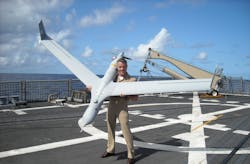Small unmanned aircraft like the Insitu ScanEagle and Blackjack may help reshape naval maritime surveillance
WASHINGTON – Equipping surface warships with small unmanned aerial vehicles (UAVs) like the Boeing Insitu ScanEagle and Blackjack, expands the fleet's surveillance horizons, lethality, and overall effectiveness at a low cost. Moreover, small UAVs are easy to launch and recover. The National Interest reports. Continue reading original article
The Military & Aerospace Electronics take:
12 April 2021 -- For several decades, navies have sought to use UAVs for conducting routine missions that require a long time on station, such as maritime surveillance and reconnaissance.
Big UAVs like the MQ-4C Triton can have limited deployments to airfields or ships with large decks such as aircraft carriers. In addition, these systems are expensive to operate, albeit less costly than most manned aircraft.
One challenge to deploying UAVs on surface ships has been a lack of space aboard. Even ships designed with a flight deck and hangar have limited space for which unmanned aircraft must compete with manned helicopters. The answers may be small UAVs like the Boeing Insitu ScanEagle and Blackjack.
Related: Northrop Grumman moves forward on developing long-endurance maritime UAV for small ships
Related: Triton maritime surveillance UAV technology upgrades: Navy's just getting started
John Keller, chief editor
Military & Aerospace Electronics
